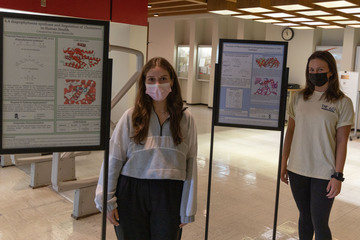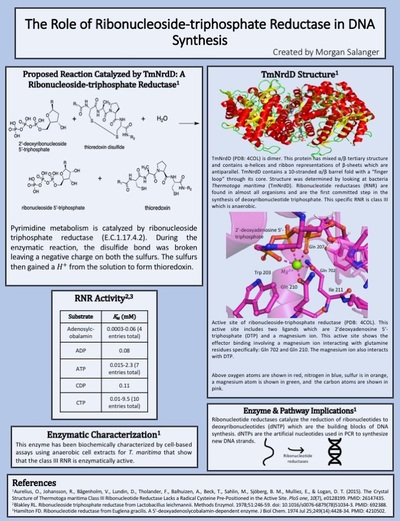
09/27/2021
This past spring, SUNY Cortland seniors Alexis Mastrelli and Morgan Salanger were among the students in a biochemistry class who were tasked with creating posters to explain the structure and function of metabolic enzymes.
Those posters are now on display both in the lobby of Memorial Library and online through the Digital Commons repository.
Recent SUNY Cortland graduates Sidney Campbell ’21 and Samantha Stabinsky ’21 also have their posters from this project displayed in the library. Other SUNY Cortland students who worked with Associate Professor Katherine Hicks and have their work included in the Digital Commons include seniors Alexander Guerrero and Thomas Roe.
Hilary Wong, instructional services librarian, suggested posting the completed infographics to the Digital Commons and secured the space for the physical display at Memorial Library. One of the objects of this project was for students to explain a complex scientific concept for a general audience. Displaying the posters in a prominent location will catch the eyes of faculty and staff as well as science majors and non-science majors alike.
This project also involved collaboration with students and faculty at Cal Poly Pomona.
Mastrelli, a biochemistry major from Farmingdale, N.Y., focused on 4,4’ diapophytoene synthase and the regulation of cholesterol in human health. Salanger, a biochemistry major with a minor in exercise science, examined the role of ribonucleoside-triphosphate reductase in DNA synthesis.
Biochemists study metabolic pathways to understand the series of chemical reactions that happen within the cells of living organisms. Mastrelli’s poster, for instance, explores how a particular enzyme could alter cell chemistry in humans that would allow it to be useful as a cholesterol-lowering therapy.
Using software called UCSF Chimera and PyMOL, the students were able to visualize and analyze molecular structures and create graphics for the posters.

“We knew that everything we did, it was our work that we put into it,” Salanger said. “We weren’t looking at other structures. We had to make the structures and make sure they were exact. There were a lot of revisions that went into the final product and Dr. Hicks gave us a lot of feedback.”
The students worked through their assignments with assistance from Hicks from SUNY Cortland’s Chemistry Department and virtually with students and Associate Professor of Biochemistry Kathryn McCulloch from Cal Poly Pomona.
“Our professors posted a collaborative blackboard so we could talk to the students in California and bounce off each other,” Mastrelli said. “Things like, ‘I ran into this problem, what did you do?’”
Mastrelli is currently deciding between applying to dental or pharmacy school. Salanger is considering a career as a nurse anesthetist.
They’ve both benefitted greatly from this project and other opportunities in SUNY Cortland’s biochemistry major, which graduated its first student in 2013. With a combination of small class sizes, opportunities for hands-on research and preparation for grad school or a wide variety of careers, the major is a great fit for students interested in an interdisciplinary approach to science.
“The tools we were using, learning them has helped me in my classes now,” Mastrelli said. “It’s a good skill to know how to make publication-quality figures and protein models and reactions.”